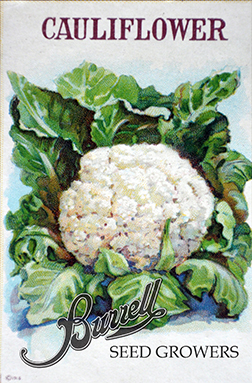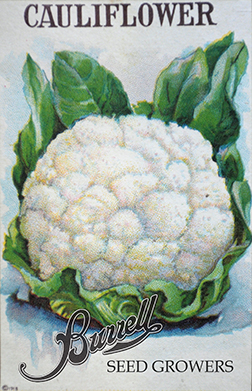Growing Cauliflower.
Cauliflower is a nutritional powerhouse that surpasses broccoli in vitamin and mineral content. This old standard is gaining popularity as a pizza crust ingredient. Although classic dishes like cauliflower with cheese sauce or cauliflower florets caramelized in garlic and olive are hard to beat. Either way, it belongs in my garden.
From our 1922 Catalog: Cauliflower, although one of the most delicate vegetables, is but little grown except by professional gardeners because of the erroneous notion that it is so difficult to grow that only skilled gardeners can produce it. Anyone will be reasonably sure of success with this most desirable vegetable if the cultural directions given below are carefully observed. For spring and early summer crop, sow in March or early in April in hot bed and transplant to cold frame when sufficiently large to handle. As soon as danger of hard freezing is over set in the open ground in rows 2% feet apart and 18 inches apart in the row. The plants will endure a light frost. The soil for cauliflower should be like that for cabbage, but it is better if made richer than is ordinarily used for that crop. Plenty of good manure must be well incorporated with the soil and the latter be brought into the highest state of tilth. No application, however, can be more necessary or more useful than that of cultivator and hoe. For late crop, sow at same time as for late cabbage and treat in the same manner. It should be borne in mind that cauliflower will not head up well in hot, dry weather and hence the sowings need to be so timed as to bring the heads to maturity either before the hot summer weather sets in or not until the cooler weather of the fall. If it receives at this time a liberal supply of water, the size and quality of the heads will be greatly improved. After the head begins to form, draw the leaves over and tie them together to protect it from the sun and keep it white. Each time you go over and tie the heads as above it is a good plan to’ use a different colored string. Calico strips are usually used. This will help you when cutting the heads to know which are ready. The heads should be cut for use which the “curd” is compact and hard, as they soon become much impaired in quality and appearance after they open and separate into branches.
Good companion crops are lilliput zinnias, bush beans, onions, celery and radishes. Bad companion crops are peas and strawberries.
Growing Cauliflower.
Cauliflower is a nutritional powerhouse that surpasses broccoli in vitamin and mineral content. This old standard is gaining popularity as a pizza crust ingredient. Although classic dishes like cauliflower with cheese sauce or cauliflower florets caramelized in garlic and olive are hard to beat. Either way, it belongs in my garden.
Cauliflower requires more ‘know how’, preferring a long cool season. Pick a location that gets a minimum of 6 hours of sun. Light shade during the heat of the day is fine. Starting our heirloom cauliflower seeds in a greenhouse is ideal, but in a warm climate, direct seeding works too. Transplant seedlings 2-4 weeks before last spring frost date. Row covers are optional, but a good idea if your climate is a bit risky. In warm areas, time cauliflower transplanting like cabbage, 8 to 10 weeks before first fall frost date. When planting cauliflower seeds, sow 10 to 12 weeks before fall frost. Space 2′ apart in rows 3′ to 4′ wide.
Cauliflower requires consistent moisture. If allowed to dry out, it may start to bolt and yield loose heads. Monthly feedings and mulching are beneficial. To blanche, tie ends of leaves around heads when they are 2 to 3 inches in diameter. (Some varieties do not require this.) Cauliflower is ready to harvest approximately two weeks after blanching.
Good companion crops are lilliput zinnias, bush beans, onions, celery and radishes. Bad companion crops are peas and strawberries.



